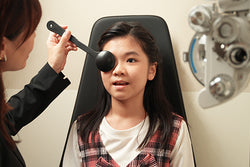
Understanding Amblyopia
Amblyopia typically takes root before a child reaches the age of six2. This condition is more common than you might think, with an estimated 3% of children under six years old experiencing some form of amblyopia3. To prevent long-term consequences, early detection and intervention are crucial.
Common Causes of Amblyopia
Amblyopia can have various underlying causes, each affecting a child's visual development differently. The most common ones include:
Strabismus (Eye Misalignment): When a child's eyes are misaligned, meaning they do not work together as a team, it can lead to amblyopia. One eye may deviate from the straight-ahead position when focusing on an object, causing confusion in the brain4.
Uncorrected Large Refractive Errors: Highly nearsightedness, farsightedness, or astigmatism in one eye can result in amblyopia, especially when the other eye has normal vision5.
Asymmetrical Refractive Errors: A significant difference in vision between the two eyes can cause amblyopia in the eye with poorer vision6.
Eye Conditions: Congenital cataracts, droopy eyelids, and other structural issues in the eye can also contribute to amblyopia7.
Signs and Symptoms to Watch For
Identifying amblyopia in your child can be challenging, as the condition can develop without obvious outward signs. However, there are some subtle cues that parents can look out for, including:
Eye Deviation: Does your child's eye appear to wander or turn away from the straight-ahead position when focusing on an object?
Head Tilt: Does your child frequently tilt their head when looking at an object, perhaps as an attempt to see it more clearly?
Depth Perception Issues: Does your child struggle to gauge the distance of objects correctly?
Eye Covering: Does your child frequently cover one eye while looking at things?
Bumping into Objects: Does your child tend to bump into objects or have difficulty with activities that require a sense of space?
Early Detection and Management
The good news is that amblyopia can often be corrected with the right interventions, especially when it is detected early. Typical treatment includes:
Prescription Glasses or Contact Lenses: Correcting significant refractive errors is the first step toward improving vision in the affected eye8.
Eye Patching: To encourage the use and development of the amblyopic eye, eye patching of the good eye may be prescribed. This helps the brain recognise and process visual information from the amblyopic eye9.
How Regular Eye Examinations Can Help Your Child
To safeguard your child's visual health, it is essential to schedule regular eye examinations. Experts recommend that children visit their eye care practitioner every six months for a comprehensive eye check-up. Early detection of amblyopia can make all the difference in preserving and enhancing your child's vision.
Our eye care professionals at Spectacle Hut are well qualified to conduct a comprehensive eye exam for your child. Book an appointment here at your nearest store.




